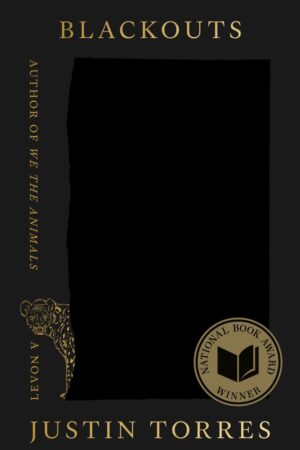Blackouts
by Justin Torres
reviewed by Steven Flores
Justin Torres seems less a writer than a force of nature. His accolades are the stuff of dreams for most writers—the Stegner Fellowship at Stanford, the Radcliffe Fellowship at Harvard, the National Book Foundation’s 5 Under 35 Award—and now to this already impressive list he has added the 2023 National Book Award, the crème de la crème of writing prizes, for his latest novel, Blackouts.
Until recently, however, Torres’s fans contented themselves with just one book—the lyrical, elliptical Bildungsroman We the Animals. At a slim 128 pages, We the Animals is a novel whose elegance derives from its simple structure and the poetic compression of its linear, time-lapsed vignettes. With dazzling economy, the straightforward story bounds ahead through a young Boricua boy’s life as the intersectional pressures of poverty, machismo, and domestic strife threaten to quash an emerging queer identity and cleave him from his beloved brothers.
These elements—queerness, Puerto Rican identity, marginalization—are still present in Blackouts, but the treatment differs greatly in this structurally complex, architectonic novel. Whereas We the Animals is a no-assembly-required Bildungsroman, Blackouts is a historiographic metafiction that examines a queer past under threat of erasure.
The plot of Blackouts involves an unnamed narrator visiting a place simply called “the Palace” at the request of a man called Juan Gay. Juan is an aging, gay Puerto Rican man whose dying request is that our narrator tell the story of Jan Gay, a real-life lesbian sexologist whose contributions to the field were all but erased in a time when homosexuality was pathologized and any writing on the subject was not authorized unless it bore the imprimatur of a (white) male doctor. Despite having conducted and organized the majority of the field work, Jan’s contribution is marginalized to a single acknowledgment, and her history is assimilated into a project which seeks to define homosexuality as pathology rather than ontology, as something acquired rather than innate. Too proud and having come too far to let this stand, Juan implores our narrator—whom he refers to as “nene,” or “sweetheart”—to tell Jan’s story. The narrator reads between the lines, discerning:
There were three stories Juan wanted me to alloy: (1) The story of how I’d arrived at the Palace … (2) the story of the Sex Variants study itself, Jan Gay’s story, to be told after Juan’s death … (3) the final story of Juan’s own, though he’d never admit it.
These, more or less, are the storylines of the novel, and the action of the novel takes place almost entirely within Juan’s room at the Palace. As the narrator (“nene”) and Juan trade stories, it becomes clear that the only way of redressing the erasures of the past is to fill the lacunae with fiction. Thus, a story is spun out of scholarship. Like a kintsugi potter, Torres places the emphasis on the breaks and ruptures that give history its verve and beauty, acknowledging its necessary narrative (even fictive) components. Of course, writing into the archive is nothing new for historical novelists, but the difference here is that Torres rather beautifully incorporates actual historical materials—advertisements, letters, photographs, and illustrations—all centered around the erasures, or “blackouts,” of Sex Variants: A Study in Homosexual Patterns, the 1941 book by George W. Henry that appropriated the work of Jan Gay.
Blackouts shows that every historical narrative contains within it the possibility of a counternarrative. It also suggests that, for each of us, there are gaps and ruptures of our identity—the book’s titular blackouts—that are held together by the continuity of narrative. This narrative work often happens on a subliminal level, where past and present, fact and fiction, history and literature come together. What we read, then, is particularly important, and it is Juan who impresses upon “Nene” the “idea that stigmatized persons live in a literarily defined world,” and there is “value in getting lost—sometimes haunted, sometimes enriched—in what has been said about you and your kind, and what’s been erased or suppressed.”
Taken in tandem, those statements seem to be a cri de coeur for a novel that avoids didacticism in favor of inquiry. Indeterminacy reigns as the novel seems to continually undercut its own reality in a manner reminiscent of magical realism or mid-career Nabokov, so that the reader is not entirely sure how to interpret the course of events. For instance, as the story progresses, the reader wonders whether the Palace is a kind of desert sanatorium for pathologized queerness or, as the novel coyly hints, a ghost town serving as a way station for queer ghosts in the style of Pedro Páramo, the acclaimed 1955 novel by Mexican writer Juan Rulfo. As Juan Gay reminds our narrator, “Not all ambiguities need to be resolved,” and indeed, the charm of the novel lies in its embrace of uncertainty.
This uncertainty, of course, is not for everyone. There will undoubtedly be readers who prefer the more straightforward storytelling of Torres’s first novel to his expansive and diffuse second. Indeed, the postmodern inclusion of the “paratext” (think Pale Fire lite), the homage to Manuel Puig’s Kiss of the Spider Woman, and the magpie modes of narration might overwhelm some readers. Perhaps that’s the point—to notice the constructedness of the text itself. “The ugly fact,” as Cormac McCarthy famously said, “is that books are made out of other books.” For populations literarily defined—in this case, queer folks—Torres’s novel creates coherence out of a fractured narrative, reclaiming the stories of the unsung heroes in queer history.
Published on March 25, 2024

